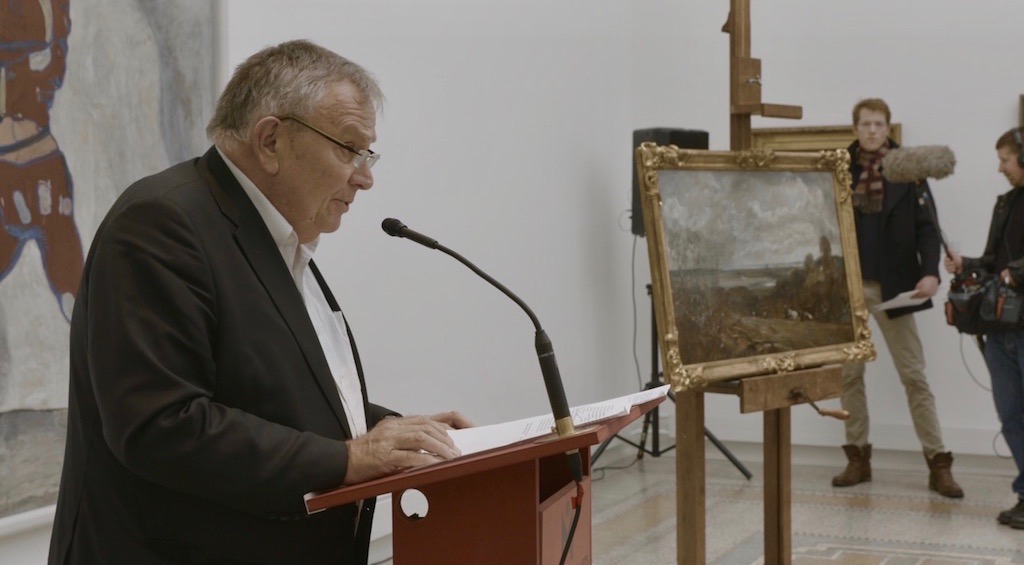[ad_1]
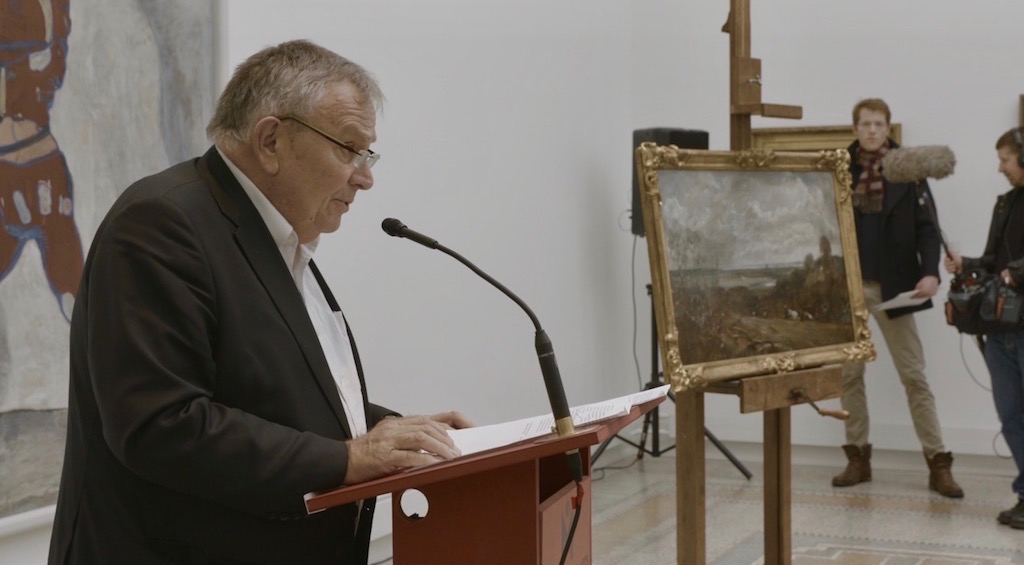
Alain Monteagle at the the Musée des Beaux-Arts in La Chaux-de-Fonds, Switzerland.
MARCUS WINTERBAUER
Since World War II, Switzerland has been known as a safe haven and protective host for all manner of holdings—works of Nazi-looted art among them. But the recent restitution of a prized painting to a retired French history teacher suggests a potential shift in a legacy of Swiss intransigence on matters of ill-gotten art.
On March 12, after a grueling decade-plus struggle from his home base outside Paris, Alain Monteagle recovered a painting by John Constable, Dedham from Langham (1813), that had been stolen in 1942 from his grandfather’s aunt. “I’ve regained a part of my family,” Monteagle said at an emotional ceremony at the Musée des Beaux-Arts in La Chaux-de-Fonds, Switzerland. “I am full of joy.”
Given Switzerland’s history as a destination for Nazi-seized art during wartime and its unfavorable legal posture toward restitution ever since, the return of the painting marked an unusual victory for heirs of looted art. Previously, nearly all known restitution cases in Switzerland have concerned antiquities from the Mediterranean and the Middle East. In a comprehensive article in 2013, SWI Swissinfo documented only two prior cases related to Nazi-looted art: the return of a painting by the German artist Max Liebermann in 2000 and the restitution of a picture by the Swiss painter Albert von Keller in 2010.
More recently, in 2014, the Kunstmuseum Bern agreed to return any looted work from a collection of some 1,500 works bequeathed from the late Cornelius Gurlitt, the reclusive art collector whose father, Hildebrand Gurlitt, was a Nazi-era art dealer.
The newly restituted Constable painting—which is slated to be exhibited at Christie’s in New York starting April 16 and put up for auction in London in July—had been purchased by Monteagle’s distant aunt Anna Jaffé and her husband John from the Sedelmeyer Gallery in Paris in 1907. The Jaffés had prospered as linen merchants and built a collection of about 60 artworks so notable that Henry James and Marcel Proust came to view them.
Following the death of her husband and the 1940 Nazi occupation of France, Anna, a childless British expatriate, specified in her will that, “considering the new tragic situation,” the paintings in her collection should go to her family. But soon after her death in 1942, at the age of 97, France’s Vichy government—prodded by Hitler’s art adviser Karl Haberstock, a high official in the Reich’s well-funded looting program—seized the collection from her home. At a forced sale in 1943, an unnamed intermediary gained possession of the Constable and took it to Switzerland, where it was acquired by Georges Moos, a gallerist in Geneva.
In 1946, the Constable was bought by collectors and patrons Madeleine and René Junod, with whom it remained for 40 years. After the death of René and later, in 1986, of Madeleine, the work was bequeathed with others from their collection to the Musée des Beaux-Arts in La Chaux-de-Fonds, a center of the Swiss watchmaking industry located along the border with France.
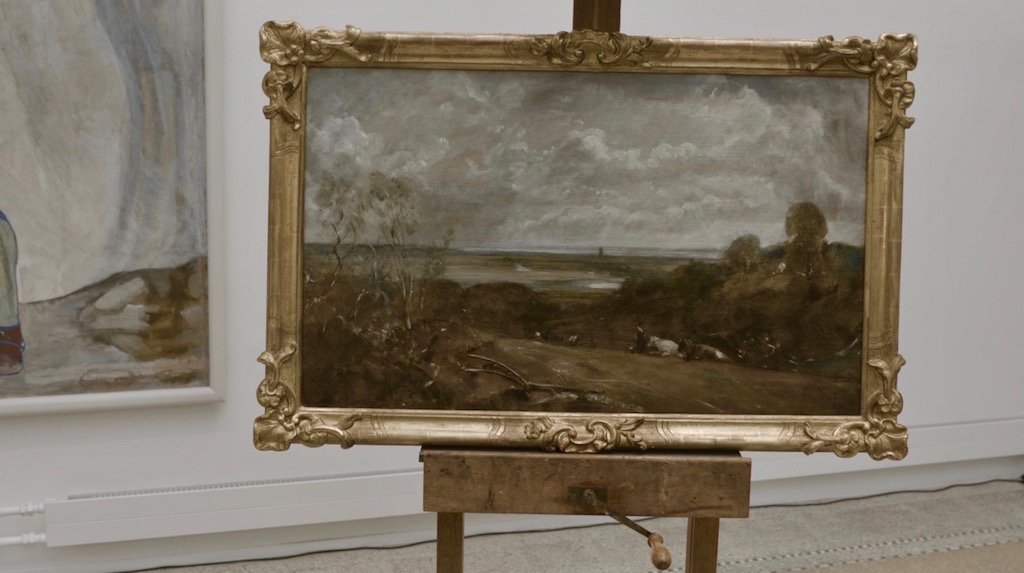
John Constable, Dedham from Langham, 1813, at the the Musée des Beaux-Arts.
MARCUS WINTERBAUER
In 2004, two characters Monteagle described as “shady figures” approached him with an offer of help to reclaim paintings from his family’s dispersed collection, supposedly in Russia and the Ukraine. They proposed an arrangement to serve as his sole representatives and award him and other Jaffé heirs half of any proceeds earned as a result of restitution and subsequent sales. But wary of their motives, Monteagle and his family decided to begin research and recovery themselves.
The restitution of the Constable is notable for an unusual and protracted process that might easily have deterred others. But the modest, unassuming demeanor of Monteagle—a gentle man whose blue eyes gaze over rimless glasses—belies a fierce determination in line with parts of his family’s past.
In an interview, Monteagle recounted that his grandfather Gustave Cohen, after being dismissed for being a Jew by the Vichy regime in France, set sail for the United States, where he founded a “French university in exile” with the noted French scholars Henri Peyre and Claude Lévi-Strauss before joining Charles de Gaulle’s provisional anti-Vichy government in Algiers. Monteagle’s own parents met as members of the Free French resistance movement and acted as liaison officers between the French and Americans following the invasion of Normandy.
“My mother inspired me—she was a fighter, and she loved tante Anna,” Monteagle said, using the French word for aunt. Anna Jaffé had served as a kind of substitute mother and introduced her great niece to the “Old Masters—Turner, Guardi, Goya. My mother passed this taste in art on to me.”
As he researched his family’s lost paintings, Monteagle discovered the Constable in a catalogue of the Swiss museum that matched a log of the forced sale in 1943 as well as the Sedelmeyer Gallery purchase from decades before. But when, in 2006, he requested that the Constable be returned, the city of La Chaux-de-Fonds, which owns the Musée des Beaux-Arts, sent a letter stating that “it could not freely dispose of this property which belongs to the public collectively.”
Undaunted, Monteagle met in 2008 with representatives of the museum and the city to provide documentation, including the catalogues and the purchase record, and stake his claim. He was accompanied by journalists from a French TV station, which broadcast footage afterward of a dignified Monteagle making his impassioned case.
City authorities consulted with international cultural organizations and members of the local Jewish community. But about a year later, the city again declined to return the painting, citing a Swiss law stating that an artwork purchased “in good faith” was exempt from restitution—an argument effective in blocking the return of Nazi-looted art.
Complicating the case was tension between “the moral obligation to return the painting and the legal obligation to keep the collection undivided,” as the Musée des Beaux-Arts’ director, David Lemaire, put it a few weeks ago in an email interview. The will of Madeleine Junod had stipulated that the paintings she bequeathed to the museum were not to be separated, so there was concern that restituting the Constable would violate the terms of the will and run the risk of precipitating legal action from both Junod’s heirs and the citizens of La Chaux-de-Fonds. As an attempted workaround, city authorities affixed a plaque below the painting clarifying that it had been looted by the Vichy regime. Monteagle found this insufficient.
During the run of The Monuments Men, the 2014 George Clooney-directed movie about World War II-era efforts to recover Nazi-stolen art, Monteagle paid a visit to La Chaux-de-Fonds and tried a different—and more dramatic—tactic. He set up a table at an outdoor market and handed out a flier titled “The Looting of Art in War,” with an invitation for passersby to sign a petition. But his effort fell short since such a petition needed to be initiated by a local voter to become a referendum.
Years passed, and, according to Lemaire, Monteagle stayed “silent” during the intervening time. Monteagle himself characterized the period differently. “Every two months, my lawyer and I would send emails, letters, and phone calls to the city asking to meet and talk, but no one answered. The French ambassador came to support us, but the mayor did not meet with him. We wrote a letter to the city’s lawyer, saying that either the woman who donated the painting knew it was looted art and that her donation was illegal, or she did not know and would have restituted it. We received a very aggressive answer, the first in years, saying we had no right to restitution because France did not recognize us, meaning we were looters ourselves.”
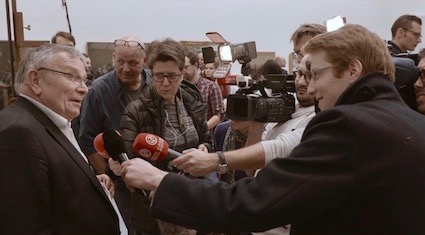
Alain Monteagle at the the Musée des Beaux-Arts.
MARCUS WINTERBAUER
To date, eleven of the sixty paintings in the original Jaffé collection have been returned to Monteagle and other Jaffé heirs, including by institutions such as the Kimbell Art Museum in Forth Worth, Texas, and the Louvre in Paris. So far, the Constable case with the Musée des Beaux-Arts has proven the most difficult.
In contrast to his dueling with officials in La Chaux-de-Fonds, Monteagle in 2005 contacted the Kimbell and asked for the return of William Turner’s Glaucus and Scylla (1841). After two months of discussion, it was agreed that the work would hang in the museum and be returned a year later. Overwhelmed when he first saw the painting, Monteagle told the Fort Worth Star-Telegram that he did something that day he hadn’t done since the birth of his children. He wept.
In 2016, in a notable break for the Constable case, Ronald S. Lauder, president of the World Jewish Congress and chairman of the Commission for Art Recovery, addressed Monteagle’s ordeal in a speech to the Swiss Jewish Community Federation in Zurich. “The Jaffé family retrieved several of their other paintings from various countries, because the ownership was quite clear,” Lauder said. “All institutions in various countries cooperated except one: the Chaux-de-Fonds museum. . . . This decision, I believe, shows a troubling lack of shame.”
Later that year, in the wake of Lauder’s address, Monteagle filed a lawsuit with the regional court in La Chaux-de-Fonds. His lawyer, Marc-André Renold, said that it would be the first Nazi-looted art case to go to court in Switzerland that he was aware of. However, a settlement was agreed upon out of court before any official decision that might have been reached.
While Lauder’s speech undoubtedly influenced international public opinion, a decisive procedural factor was a decision by the French Commission for the Compensation of Victims of Spoliation (CIVS), created in 1999 for Jewish families deprived of property due to anti-Semitic legislation during the Nazi occupation of France. In September 2017, the city administration of La Chaux-de-Fonds voted unanimously in favor of restitution. However, a payment of €80,000 (about $100,000) would be required to retrieve the painting, half of which would go to the Junod heirs and half to the city. In acknowledgement of the Vichy regime’s damning role in looting, the fee was paid by the French CIVS.
According to Lemaire, the museum director, the involvement of the CIVS “legally enshrined the fact that the city and the museum had [been] effective and legitimate owners of the painting within the meaning of Swiss law.” As a result, he said, the museum, with the approval of the Junod heirs, decided to restitute the painting on the basis of “moral issues.”
Monteagle said he was pleased with the support of the CIVS “but never asked them for any money.” He knew of no similar case involving such a fee and hoped that, in the future, the commission “does not feel obligated to pay any institution to return art looted from Jews.”
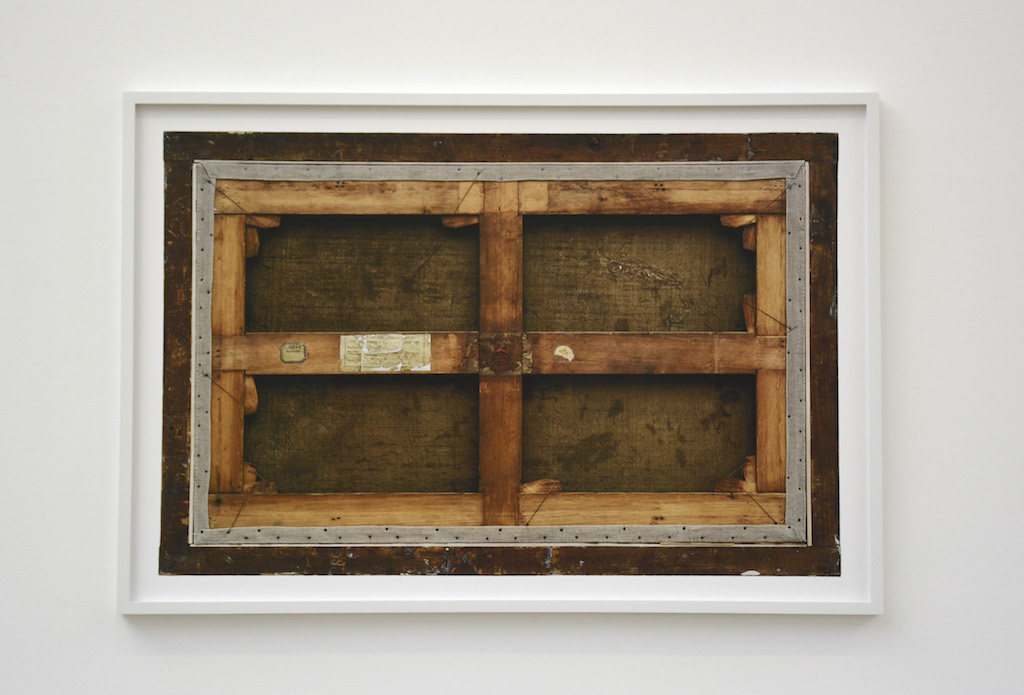
Philippe Gronon’s photograph of the back of John Constable’s Dedham from Langham (1813) on a wall at the Musée des Beaux-Arts.
COURTESY MUSÉE DES BEAUX-ARTS
In an unexpected move, the Musée des Beaux-Arts commissioned French photographer Philippe Gronon, known for his images of the verso side of paintings, to take a picture of the back of Constable’s Dedham from Langham showing previous ownership information and exhibition markings from the painting’s past. That image now hangs on a museum wall near the entrance to the room where the painting had been displayed. “We can’t see that painting any more, but we started to watch it with new eyes, historically informed,” Lemaire said.
Twelve years ago, Monteagle’s success was barely imaginable. Now, his quest illuminates the legal, ethical, and personal hurdles encountered by many heirs whose fight to reclaim a family legacy is often about much more than the art.
“It is essential to have paintings returned so as to refuse the efforts of the Nazis and their collaborators to suppress Jewish culture,” Monteagle said. “Little by little, with each returned painting, we understand the life of the people we love—although they died long ago.”
The authors are producing a feature-length documentary film on the restitution of art stolen from Jews by the Nazis.
[ad_2]
Source link

